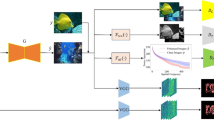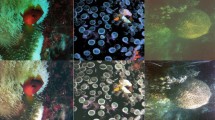Abstract
Underwater optical images are widely used in marine exploration. Due to the weak light problem caused by water depth, underwater images generally have the characteristics of background noise, dark brightness, strong blue‒green background color, and blurred images. These characteristics bring great inconvenience to marine exploration tasks. In this way, the study of underwater image enhancement has important application value. Most of the existing underwater image enhancement methods mainly solve the problem of the overall denoising and brightness enhancement of the underwater image while ignoring the partial denoising of the image. To solve these problems, this paper proposes an improved generation adversarial network (GAN) to achieve clear processing of underwater images. The main improvements include three aspects. First, a portion denoising module is added to the generator to weaken the image noise produced by the generator in a detailed manner. Second, the acceleration module is introduced into the discriminator to accelerate the training process of the GAN network. Third, the sum of squares of confrontation loss, contrast loss and color loss is used as a loss function to make the training of the GAN network stable. Extensive experimental results show that the proposed model is superior to the comparison method in both quantitative and qualitative experiments, and the visualization results of the results are natural.











Similar content being viewed by others
Data availability
The raw/processed data required to reproduce these findings cannot be shared at this time as the data also forms part of an ongoing study.
References
Carlevaris-Bianco N, Mohan A, Eustice RM (2010) Initial results in underwater single image dehazing. OCEANS 2010 MTS/IEEE SEATTLE, pp. 1–8. https://doi.org/10.1109/OCEANS.2010.5664428
Chang, J., Du, L.: Improvement of dark channel defogging algorithm based on duided filtering. Int. Conf. Virt. Real. Intell. Syst. (ICVRIS) 2020, 919–922 (2020). https://doi.org/10.1109/ICVRIS51417.2020.00224
Chiang, C.-Y., et al.: Color enhancement for four-component decomposed polarimetric SAR image based on a CIE-Lab encoding. Remote Sens. 10(4), 545 (2018)
Dai, C., et al.: Single underwater image restoration by decomposing curves of attenuating color. Opt. Laser Technol. 123, 105947 (2020)
Diao, Y.W.M.: A novel underwater image restoration algorithm. Int. J. Perform. Eng. 14(7), 1513 (2018)
Dixit, S., Tiwari, S.K., Sharma, P.: Underwater image enhancement using DCP with ACCLAHE and homomorphism filtering. 2016 International Conference on Signal Processing, Communication, Power and Embedded System (SCOPES), pp. 2042–2046. (2016). https://doi.org/10.1109/SCOPES.2016.7955807.
Fabbri, C., Islam, M.J., Sattar, J.: Enhancing underwater imagery using generative adversarial networks. IEEE Int. Conf. Robot. Autom. (ICRA) 2018, 7159–7165 (2018a). https://doi.org/10.1109/ICRA.2018.8460552
Fabbri, C., Islam, M.J., Sattar, J.: Enhancing underwater imagery using generative adversarial networks. 2018 IEEE International Conference on Robotics and Automation (ICRA). IEEE (2018b).
Fu, X., et al.: Clearing the skies: a deep network architecture for single-image rain removal. IEEE Trans. Image Process. 26(6), 2944–2956 (2017)
Fu, X., et al.: Lightweight pyramid networks for image deraining. IEEE Trans. Neural Netw. Learn. Syst. 31(6), 1794–1807 (2019)
Ghani, A.S.A., Isa, N.A.M.: Underwater image quality enhancement through composition of dual-intensity images and Rayleigh-stretching, 2014 IEEE Fourth International Conference on Consumer Electronics Berlin (ICCE-Berlin), pp. 219–220. (2014). https://doi.org/10.1109/ICCE-Berlin.2014.7034265
Goodfellow, I., et al.: Generative adversarial nets. Advances in neural information processing systems. Generative Adversarial Networks (2014)
Gu, K., et al.: Automatic contrast enhancement technology with saliency preservation. IEEE Trans. Circuits Syst. Video Technol. 25(9), 1480–1494 (2014)
Hamza, M., et al.: Feature attention network (FA-Net): a deep-learning based approach for underwater single image enhancement. Fourteenth International Conference on Digital Image Processing (ICDIP 2022), vol. 12342. SPIE (2022).
He, K., Sun, J., Tang, X.: Single image haze removal using dark channel prior. IEEE Trans. Pattern Anal. Mach. Intell. 33(12), 2341–2353 (2011). https://doi.org/10.1109/TPAMI.2010.168(DCP)
He, K., et al.: Deep residual learning for image recognition. Proceedings of the IEEE conference on computer vision and pattern recognition (2016).
Hitam, M.S., et al.: Mixture contrast limited adaptive histogram equalization for underwater image enhancement. 2013 International conference on computer applications technology (ICCAT). IEEE, (2013).
Huang, D., Wang, Y., Song, W., Sequeira, J., Mavromatis, S.: Shallow-water image enhancement using relative global histogram stretching based on adaptive parameter acquisition. In: Schoeffmann, K., et al. (eds.) MultiMedia Modeling. MMM 2018. Lecture Notes in Computer Science, vol 10704. (2018a).
Huang, J., et al.: Range scaling global u-net for perceptual image enhancement on mobile devices. Proceedings of the European conference on computer vision (ECCV) workshops (2018b).
Hummel, R.: Image enhancement by histogram transformation. Comput. Graph. Image Process. 6(2), 184–195 (1977). https://doi.org/10.1016/S0146-664X(77)80011-7
Ignatov, A., et al.: Wespe: weakly supervised photo enhancer for digital cameras. Proceedings of the IEEE Conference on Computer Vision and Pattern Recognition Workshops (2018).
Ioffe, S., Szegedy, C.: Batch normalization: accelerating deep network training by reducing internal covariate shift. International conference on machine learning. PMLR (2015).
Isola, P., Zhu, J., Zhou, T., Efros, A.A.: Image-to-image translation with conditional adversarial networks. IEEE Confer. Comput. vis. Pattern Recognit. (CVPR) 2017, 5967–5976 (2017). https://doi.org/10.1109/CVPR.2017.632
Jackson, J., et al.: Hybrid single image dehazing with bright channel and dark channel priors. 2017 2nd International Conference on Image, Vision and Computing (ICIVC), pp. 381–385. (2017). https://doi.org/10.1109/ICIVC.2017.7984582.
Jian, S., Wen, W.: Study on underwater image denoising algorithm based on wavelet transform. Journal of Physics: Conference Series, vol. 806. No. 1. IOP Publishing, (2017).
Jifara, W., et al.: Medical image denoising using convolutional neural network: a residual learning approach. J. Supercomput. 75(2), 704–718 (2019)
Jin, H., Qin, X., Guo, B.: Automatic white balance algorithm based on gray world and white point detection. Chin. J. Electron Devices 34, 226–231 (2011)
Jung, S.-W.: Enhancement of image and depth map using adaptive joint trilateral filter. IEEE Trans. Circuits Syst. Video Technol. 23(2), 258–269 (2012)
Karras, T., Laine, S., Aittala, M., Hellsten, J., Lehtinen, J., Aila, T.: Analyzing and improving the image quality of StyleGAN. IEEE/CVF Conf. Comput. vis. Pattern Recognit. (CVPR) 2020, 8107–8116 (2020). https://doi.org/10.1109/CVPR42600.2020.00813
Li, C., Quo, J., Pang, Y., Chen, S., Wang, J.: Single underwater image restoration by blue‒green channels dehazing and red channel correction. 2016 IEEE International Conference on Acoustics, Speech and Signal Processing (ICASSP), pp. 1731–1735. (2016). https://doi.org/10.1109/ICASSP.2016.7471973.
Li, J., et al.: WaterGAN: unsupervised generative network to enable real-time color correction of monocular underwater images. IEEE Robot. Autom. Lett. 3(1), 387–394 (2017)
Li, C., Guo, C., Guo, J.: Emerging from water: Underwater image color correction based on weakly supervised color transfer. IEEE Signal Process. Lett. 25(3), 323–327 (2018)
Li, C., Tang, S., Kwan, H.K., Yan, J., Zhou, T.: Color correction based on CFA and enhancement based on retinex with dense pixels for underwater images. IEEE Access 8, 155732–155741 (2020). https://doi.org/10.1109/ACCESS.2020.3019354
Li, C., Anwar, S., Hou, J., Cong, R., Guo, C., Ren, W.: Underwater image enhancement via medium transmission-guided multi-color space embedding. IEEE Trans. Image Process. 30, 4985–5000 (2021). https://doi.org/10.1109/TIP.2021.3076367
Lian, L., Weijia, L., Yaozhong, W.: An underwater image enhancement algorithm based on RDCP and CLAHE. Chin. Ship Res. 14(1), 175–182 (2019)
Liu, P., Wang, G., Qi, H., Zhang, C., Zheng, H., Yu, Z.: Underwater image enhancement with a deep residual framework. IEEE Access 7, 94614–94629 (2019). https://doi.org/10.1109/ACCESS.2019.2928976
Liu, Y., Li, Q., Huo, G., Zhou, Y., Yu, D.: Underwater image dehazing based on disparity estimation and color constraint. 2021a Asia-Pacific Signal and Information Processing Association Annual Summit and Conference (APSIPA ASC), pp. 1375–1380 (2021a).
Liu, X., Zhi, G., Ben, M.C.: IPMGAN: Integrating physical model and generative adversarial network for underwater image enhancement. Neurocomputing 453, 538–551 (2021b)
Lyu, Z., et al.: An efficient learning-based method for underwater image enhancement. Displays 74, 102174 (2022)
Mello, C.D., et al.: Unsupervised learning method for encoder-decoder-based image restoration. Brazilian Conference on Intelligent Systems. Springer, Cham (2020).
Peng, Y., Cosman, P.C.: Underwater image restoration based on image blurriness and light absorption. IEEE Trans. Image Process. 26(4), 1579–1594 (2017). https://doi.org/10.1109/TIP.2017.2663846
Ronneberger, O., Fischer, P., Brox, T.: U-net: convolutional networks for biomedical image segmentation. International Conference on Medical image computing and computer-assisted intervention. Springer, Cham (2015).
Sharma, V., et al.: Classification-driven dynamic image enhancement. Proceedings of the IEEE Conference on Computer Vision and Pattern Recognition (2018).
Shi, W., et al.: Hierarchical residual learning for image denoising. Signal Process. Image Commun. 76, 243–251 (2019)
Singh, G., et al.: Underwater image/video enhancement using wavelet based on color correction (WBCC) method. 2015 IEEE Underwater Technology (UT). IEEE (2015).
Song, W., Wang, Y., Huang, D., Tjondronegoro, D.: A rapid scene depth estimation model based on underwater light attenuation prior for underwater image restoration. In: Hong, R., Cheng, W.H., Yamasaki, T., Wang, M., Ngo, C.W. (eds.) Advances in Multimedia Information Processing-PCM 2018. (2018)
Stephan, T., et al.: Model based image restoration for underwater images. Videometrics, Range Imaging, and Applications XII; and Automated Visual Inspection. Vol. 8791. SPIE (2013)
Tan, X., Lai, S., Wang, B., et al.: A simple gray-edge automatic white balance method with FPGA implementation. J. Real Time Image Proc. 10, 207–217 (2015)
Thomas, R., et al.: Dehazing underwater images using encoder decoder based generic model-agnostic convolutional neural network. 2021 International Symposium on Ocean Technology (SYMPOL). IEEE (2021).
Ueki, Y., Ikehara, M.: Underwater image enhancement based on the iteration of a generalization of dark channel prior. IEEE vis. Commun. Image Process. (VCIP) 2019, 1–4 (2019). https://doi.org/10.1109/VCIP47243.2019.8965726
Wang, S., et al.: Naturalness preserved enhancement algorithm for nonuniform illumination images. IEEE Trans. Image Process. 22(9), 3538–3548 (2013)
Wang, Y., et al.: UIEC^ 2-Net: CNN-based underwater image enhancement using two color space. Signal Process. Image Commun. 96, 116250 (2021)
Xiuli, B., et al.: Statistical feature-based image histogram equalization detection method. Chin. J. Comput. 44(2), 292–303 (2021)
Zhang, H., Patel, V.M.: Density-aware single image deraining using a multistream dense network. In CVPR (2018)
Zhang, K., et al.: Beyond a Gaussian denoiser: residual learning of deep cnn for image denoising. IEEE Trans. Image Process. 26(7), 3142–3155 (2017). https://doi.org/10.1109/TIP.2017.2662206
Zhang, H., et al.: Deep stacked hierarchical multipatch network for image deblurring. Proceedings of the IEEE/CVF Conference on Computer Vision and Pattern Recognition (2019)
Zhang, X., Wang, X., Zhao, W.: Semantic label generation based on supervised attention mechanism. J. Qingdao Univ. Sci. Technol. (natural Science Edition) 42(4), 94–101 (2021)
Zhou, Y., Kangming, Y.: Domain adaptive adversarial learning based on physics model feedback for underwater image enhancement. arXiv preprint arXiv:2002.09315 (2020).
Zhu, J.-Y., et al.: Unpaired image-to-image translation using cycle-consistent adversarial networks. Proceedings of the IEEE International Conference on Computer Vision. (2017).
Author information
Authors and Affiliations
Corresponding author
Additional information
Publisher's Note
Springer Nature remains neutral with regard to jurisdictional claims in published maps and institutional affiliations.
Rights and permissions
Springer Nature or its licensor (e.g. a society or other partner) holds exclusive rights to this article under a publishing agreement with the author(s) or other rightsholder(s); author self-archiving of the accepted manuscript version of this article is solely governed by the terms of such publishing agreement and applicable law.
About this article
Cite this article
Li, X., Gu, H., Yu, S. et al. Underwater image enhancement based on a portion denoising adversarial network. Int J Intell Robot Appl 7, 485–496 (2023). https://doi.org/10.1007/s41315-023-00279-x
Received:
Accepted:
Published:
Issue Date:
DOI: https://doi.org/10.1007/s41315-023-00279-x




